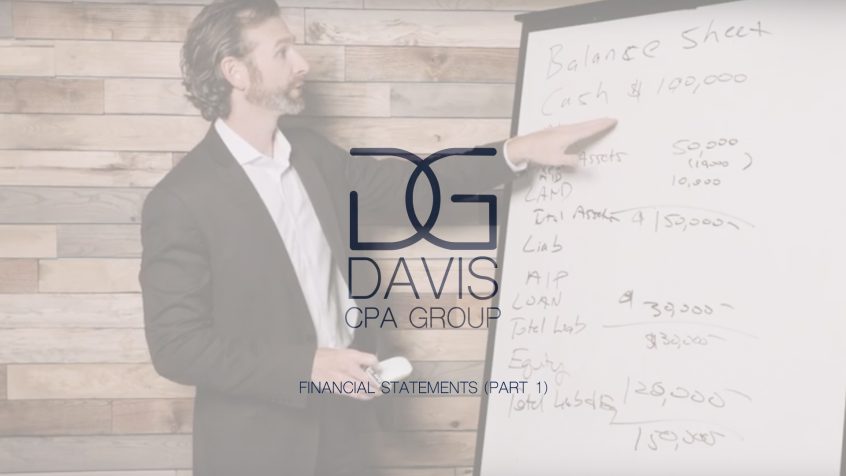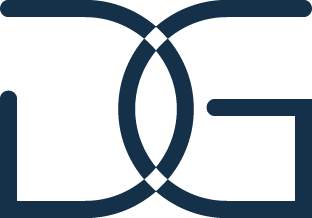Hi, Brandon Davis with Davis CPA group. Today I’m going to talk about financial statements. One of the things that as I work with my clients particularly at the business level that we have to go over on a regular basis is looking at the financial health of their business and we do that. We look at a couple of different statements that give us different information and are used for for different purposes.
The first set, and I’m going to talk about a complete set of financials. There are other statements that could be added on to this, but a complete set that I’m going to worry about for now and kind of a small business concept context is going to be your balance sheet. If I can spell it here. Balance Sheet. Your income statement also known as a profit loss. You may hear that terminology when it comes to to an income statement. And a statement of cashflows. I’m going to abbreviate here. Statement of cash flows. These statements are the three primary statements that are used to make business decisions, to look at the health and trends of your business, and also used by outsiders like bankers, and lenders, and other investors to look at the financial health of your business and basically how you’re operating.
I’m going to start with the balance sheet. The balance sheet is an interesting statement because it is what they call a snapshot in time. It lists out the assets, liabilities, and then has a equity section, which is your investment if you will, or the owner’s investment in the business. And so, it’s going to start with things like cash. So it’s going to have, let’s see, so we’ll have cash and maybe there’s a $100,000 in cash. It’s going to have other things like accounts receivable. If you have billings out there.
Your fixed assets, what those represent are those are your items that you buy that you don’t write off as an expense because there larger equipment type items, buildings, land, investments that you might make, that are longer term assets. They have a longer life. You wouldn’t expense them in a short period of time like a year. And so, that’s going to be equipment and things of that nature. Land a lot of times will be listed separately because it’s not a depreciable asset. There’s a lot of other types of assets you could have out here as far as intangibles and things of that nature but we’re not going to get too too deep there. So that would be your total assets.
So let’s say you have $50,000 in fixed assets on here as well. And so, your total assets would be $150,000 and I know [inaudible 00:00:02:40]. “What about accumulated depreciation?” There is a contra assest account called accumulated depreciation. I’m just gonna say AD. That’s a negative number that shows of the … So, say your total cost of your fixed assets. Let’s say we’re in the business of real estate and we’ve got $50,000 invested in houses and 10,000 inland associated with those houses. We get to expense a little bit of that out over time. Check out my real estate video. I talk about depreciation expense there. So, there may be an amount when you factor in here of $10,000 of a negative or a contra asset account called accumulated depreciation.
What this means, we’ve moved 10,000 of this off of the balance sheet and put it on the income statement as an expense item. I’ll talk about that when I get to the income statement. So you look at that then. So, basically you have a $100,000 in cash, $50,000 in assets minus 10 which gets us to 40 plus 10,000 on land. Those kind of wash out. So we have $150,000 then in total assets. Okay.
The next side of the balance sheet, cause again it’s a balance sheet. It’s got to balance. You’ve got your liability section. Well, this is going to be things like accounts payable. Say that I owe some people some money for work they’ve done or maybe I’ve got payroll taxes and I have liabilities out there associated with that or other short term accrued expenses. [inaudible 00:04:04] the details are accrued expenses. That’s for another video. But this is also where you put things like loans. So, let’s say for example we’ve got a $30,000 loan on this piece of property and we have no other liabilities. We’re in pretty good shape. And so, our total liabilities then. Again, I’m just going to abbreviate for time sake and such. Would be $30,000.
Well, the other side then is now we have an equity section. And so, how the, and this would basically be our investment in the business. So, in this particular case, let’s say we invested in order to … One it’s got to balance and this isn’t necessarily a plug number it’s just saying we’ve invested money in the past or we’ve accumulated income in the past via past earnings and that number sits down here in the equity side of the business. So, let’s say of the $100,000 of cash that we’ve got, and obviously $50,000 in assets, and our accumulated depreciation and such, we’ve got $30,000 in liabilities. So that would leave us about $120,000 in a equity position. And this is making a whole lot of assumptions. We haven’t distributed any of this cash out, it’s still in the business as far as our earnings and things of that nature.
Well then you get down here to total liabilities and equity. So, that’s the sum of the 30,000 and the 120 to get this to $150,000. Which then shows us that we balance. 150 minus 150. I know guys, my handwriting’s terrible but you get the point as far as what we’re trying to accomplish here. So, what’s interesting is once the balance sheet’s put together, it’s analyzed from the standpoint of where are we today from the standpoint of our total assets versus our total liabilities. And so, we started looking at things from an analytical perspective. And so say, okay, we have $150,000 in total assets, we only have liabilities of 30 so our debt to equity ratio is very good. We have very little debt to the amount of equity that we have in the business. Something else we look at, and this is called ratio analysis. And so, we start looking at pieces, and parts, and different accounts.
For example, this is a highly liquid balance sheet in the fact that it’s got $100,000 in cash. And soi you look at current assets, which current assets is a term that it talks about assets that are basically either it would be liquidated any year or have a high liquidity value in a sense of it being cash or investments, accounts receivable. Which they don’t have any in this particular fact pattern but if they did these are considered current assets. We take a look at those current assets and we divide those by your current liabilities. Well, in this case they’re zero because accounts payable again is usually something that’s due within a very short amount of time. Current maturities have this longterm debt. So we have a loan out here, maybe 5,000 of it is due in the next 12 months. So, we might move that up here in a true financial statement standpoint.
And then, look at an analysis between our total current assets versus current liability. So in this case, very strong, highly liquid company. They have lots of current assets to cover short term liabilities. And so, if we were to change this up a little bit. Let’s say they got $30,000 in a loan but they’ve got $120,000 in accounts payable. And we come down here and you say, “You know what? They’ve got basically zero equity at this point. And that can happen. What could happen is they could be pulling money out of the business personally which bleeds this equity down.
And so, maybe they’ve got, they’re living off borrowed money inside the business now. We’ve got $120,000 … I put that in the wrong one, in the liabilities. We have $120,000 now of accounts payable. Meaning the only reason we had this cash is because we haven’t paid our bills. And so, this is what a banker would look at or someone that’s well versed in financial statements would look at this and say, “What’s the health of this business?” Yeah, we’ve got $100,000 in the bank. Well, that’s pretty cool, but I look down here, well, they owe 120. So, really their current assets to the current liability situation is they don’t have enough to cover this.
So now we can look at the income statement, which we’ll look at next. Are they producing enough revenue to generate enough cash again to cover these short term liabilities? Oh, and by the way, pay this longterm debt off? So this is what a balance sheets used for. It’s a snapshot in time because tomorrow it could change. So this is day one. Day Two, they get deposit of $200,000 so now the next day they have $300,000 in cash. Maybe that was from a big, maybe we switched from a real estate company to now we’re a big consulting company. We had a big sale and we haven’t distributed that cash out yet. So, now the other side that would go into equity because now the owners have $300,000 at their disposal in the form of earnings. And so, this is where the earning section comes into play on a balance sheet is the equity. And we’ll talk about that a little bit too.
I’m trying to hit this a little high level and so I’m leaving out a few details and such but I just want to kind of get you thinking about what is the balance sheet used for. What does it report? It basically reports your assets and liabilities. So cash, accounts receivable, fixed assets, and again on the liability side, short term liabilities, longterm liabilities, then whatever’s left basically is your investment in the business for lack of a better term. So, very interesting in the fact that this can change so dramatically, so quickly, depending on which day you look at it. That’s why a lot of times in a good analytical situation, you’re going to look at multi years of balance sheets but you’re also going to look at trends on income statements. [inaudible 00:09:51]


